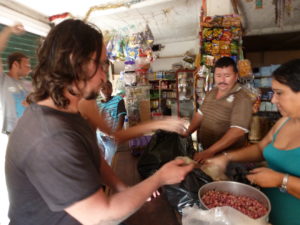
Be careful of what you ask for in Spanish…
Welcome to the final chapter on food in the Hispanic world. We’ve covered the history of Hispanic foods, from their journey from Latin America to Spain, and vice versa. We’ve explored street food around the globe and reflected on rituals and customs from the everyday to the religious and sacred. Now it’s time to address the issue of ordering food in Spanish!
Getting Started: an Approach on how to order food in Spanish
It seems that there are a heaps of pages dealing with how to order food in Spanish. We’re only going to cover the basics, but we’re also going to add a few details that you might not find on other pages.
It would be very time consuming (and quite boring) to dissect each and every country according to the types of food-ordering expressions they have, so we’re going to do something different. Take a look at the below table which covers a generic overview of the sorts of expressions you might be likely to hear in the Spanish-speaking world when you go out and order food. There are going to be all sorts of minor differences over the Hispanic globe, whether it’s the preference of one word over another, or even the manner in which you ask for things. There are far too many differences to take them all into consideration, but what we can do is work some of the key differences into the equation. All of the examples are written in first and second person, and could refer any number of different situations in restaurants, markets and food stands.
Ordering Food in Spanish
| Greetings
|
|
| buenos días/tardes/noches bienvenido/a | good/morning/afternoon/night
welcome |
| ¿quiere Ud. una mesa al lado de una ventana? | do you want a table next to a window? |
| ¿afuera o adentro? | outside or inside? |
| ¿en la terraza o adentro? | outside or inside? (when the restaurant has a terrace or garden) |
| ¿tiene Ud. una reservación? | do you have a reservation? |
| tome un asiento por favor /siéntese por favor | take a seat please. |
|
Ordering
|
|
| me trae la carta, ¿por favor? | can you bring me the menu please? |
| ¿algo para comer/para tomar? | something to eat/drink? |
| ¿qué desea? | what do you want? |
| ¿qué le traigo? | what can I bring you? |
| ¿qué me recomienda Ud.? | what do you recommend? |
| recomiendo… | I recommend |
| ¿me da un poco más de tiempo por favor? | can I have some more time please? |
| ¿qué va a pedir Ud.? | what are you going to order? |
| como plato principal, quiero… | for the main dish, I want… |
| como postre, quiero… | for dessert, I want… |
| como entrada, quiero… | for entrée, I want… |
| quisiera un/a… | I would like a… |
| me trae un/a | can you bring me |
| me da un/a… por favor. | can I have … please. |
| para mí, un/a… por favor. | for me, a…please |
| ¡buen provecho! | bon appétit! |
|
Miscellaneous
|
|
| soy alérgico/a a | I’m allergic to… |
| soy vegetariano/a | I’m vegetarian |
| ¿qué trae este plato? | what does this dish have in it? |
| poco hecho | rare |
| al punto | medium rare |
| bien cocido | well done |
|
Finishing up
|
|
| ¿cómo estuvo la comida? | how was the meal? |
| ¡muy rica /deliciosa! | very nice /delicious! |
| ¿podemos pagar por separado? | can we pay separately? |
| la cuenta, por favor. | the bill, please… |
| ¡muchas gracias! | thanks a lot! |
| hasta luego /buenas noches | see you later /good night |
Differences between English and Spanish
In Spanish, the expression which is best translated from ‘can I have’, me da, translates literally into ‘you are giving me’. ‘What’s this?’ you say, I mean, who goes into a restaurant or stands in front of a food stand and says “you are giving me a beer…..please”? Rest assured, this is fine in the Spanish-speaking world. In fact, if you use the direct English to Spanish translation of ‘can I have’, which is puedo tener, you will sound ridiculous! Puedo tener sounds like you want to have something in your possession. What does that imply? I don’t know…. your guess is as good as mine.
The other expression which might sound odd to an English-speaker’s ears is me trae (literally, ‘you are bringing me’). You’re bringing me? Really? Yep! That’s the way it is, and it sounds absolutely fine, so go ahead and say it as much as you want. Within reason, or course.

Out and about doing the shopping.
Some Differences between Hispanic Countries
While ¿qué le traigo? (what can I bring you?) is a commonly understood expression when ordering food, you might hear a Spanish waitress or waiter say ¿qué le pongo? (what can I put you?), to which one’s response would be: me pone un/a… (you are putting me a…..). Now if me trae un/a… (you are bringing me a…) sounds weird to English ears, me pone un/a… (you are putting me a…) sounds odd even to other Spanish speakers living outside of Spain.
The Colombians have a novel way of ordering food. They don’t ask you to bring it, no, they request that you give it to them for free. Yep, you heard right. The expression me regala un/a is made up of the verb regalar (to give a gift), thus seemingly indicating that the person ordering the food would like you to give them the food as a gift. At least that’s how it sounds outside of Colombia. Another uniquely Colombian expression is a la orden (at your command), which is used as a stand-in for the ubiquitous Spanish language phrase no hay de qué (that’s no problem) or de nada (you’re welcome). Where did this come from? Not sure, but it might be a left-over from colonial Spanish which now sounds outdated in many parts of the Hispanic world.
In certain countries – Argentina springs to mind – the expression me da (‘can I have,’ or literally ‘you are giving me’) appears to be not quite direct enough. It is not uncommon to hear dame (give me), followed by the words por favor (please).
What about the names of the food themselves? There is one particular food that comes to mind, which might cause a bit of confusion or amusement when asked for in Cuba. That word is papaya, which in non-Cuban Spanish means ‘paw-paw’. A pretty innocuous thing to ask for for right? Well that depends on when, where and how you’re ordering it. The word papaya is the slang word used in Cuba for the female genitalia, so how have the Cubans gotten around this interesting difference? ‘Paw-paw’ is known as la fruta bomba (the bomb fruit) in Cuba. I love it!

Churros in Spain.
As with all cases of learning expressions and vocabulary in a new language, it’s probably advisable to keep it quite neutral and basic before getting adventurous. If you have a very good grasp of the language and have been living in a particular region for some time, sure, go crazy with the ‘GIVE MEs’. Do as the locals do, but when in doubt, order using what you know best.
That concludes our entry on how to order food in Spanish and our journey into food in Spain and Latin America. Stay tuned for more articles. This is our passion, and there are an almost infinite number of topics out there! Until next time…
¡Adios!
Share this article!
